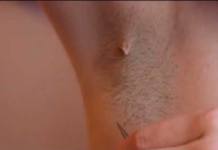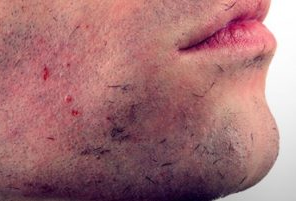An infected ingrown hair cyst or boil is the result of a grown-out hair that has curled back into the skin and become infected. When you have recurrent cases are sometimes called folliculitis. discover more in this post on the causes, symptoms and how to treat and remove infected ingrown hair.
Cyst and boils (also known as abscess) are mass of lumps that can form on any part of the skin. Boils are common in regions of the body that keep rubbing against one another. This will include parts like in the armpits, buttock cracks and on inside of thighs. The difference between the two is that, a boil is a localized bacterial infection whereas a cyst is an uninfected fluid—filled mass. So it is therefore possible for a cyst to turn into a boil and not the other way round.
An ingrown hair is hair that curled round and grown back into the skin. At that point it re-enters the skin, it can produce raised red spot, which when infected will turn into a painful, pus-filled bump known as a boil. Though common in people with curly hair, ingrown hair can happen to any one regardless of the age. They can also be itchy and embarrassing but will often go away on their own without any medical assistance.
Infected Ingrown Hair Symptoms
Ingrown hair is common among those who shave or remove hair from any part of the body. In males ingrown hair is common on the chin, back of head and around the pubic area. In females, ingrown can occur in armpits, the pubic region and on eyebrows. The symptoms of associated with ingrown hair will vary from person to person depending on the underlying cause.
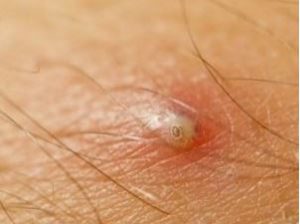
The common symptoms of an infected ingrown hair will include but not limited to the following.
- A painful boil or abscess on the infected follicle
- Itchy and painful bump
- The skin start to turn red
- The bumps will form clusters
- Burning sensation and continues urge to scratch
- Pain and tenderness
- The bumps will enlarge or become swollen
- Some people will have fluid filled blisters
- An itchy rash
What Causes Ingrown Hair Infection?
The common cause of an infected ingrown hair anywhere in the body is fungal or bacterial infection. A specific cause is pseudofollicullitis barbae, an inflammation due to poor shaving technique. This condition is characterized by a dark raised scar that commonly appears on the face, neck and groin area.
Staphylococcus that enters the body through cuts and scratches made by popping the bumps formed by ingrown hair can also result in an infected ingrown hair. An infected ingrown hair will in most cases form a bump which will be filled with pus and dead skin cells to form a boil or an abscess.
The contents of an infected boils are usually semi-solid and will produce a foul smell. To treat this infection, your doctor may prescribe oral or topical antibiotics. Mild cases of bacterial infection can also be managed at home using simple natural remedies like fresh aloe Vera gel and raw garlic.
You need to avoid scratching or plucking the ingrown hair to prevent against bacterial infection. Maintain high levels of personal hygiene to prevent bacterial accumulation on skin. You also need to reduce skin irritation which causes damaging of the hair follicle.
Common symptoms of an infected hair follicle or ingrown air will include itching, pus-filled blister that will break open and crust over, the skin around the bump will become red and inflamed, the skin will feel tender and painful in in most cases, a large swollen bump will be seen.
Pictures, Images or Photos of Infected Ingrown Hair
Below and through this article, we have provided images and pictures to give a vivid illustration of how an infected ingrown hair will look like. Some may be graphical but we assure you hey will be able to help.Deep Infected Ingrown Hair photo
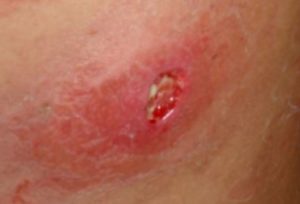
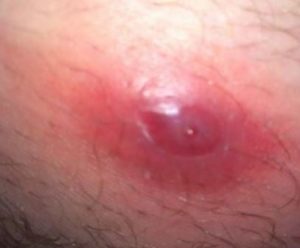
Deep Infected Ingrown Cyst
Through not common, it is possible for you to have a deep infected ingrown hair cyst. The common likely symptoms will include, yellow or green pus, itching, inflammation, tenderness and redness on the infected area.
Severe cases of the infected ingrown cyst can be treated by use of both topical and oral antibiotics. To reduce inflammation, your health care provide may prescribe steroid creams and gel. Avoid drain to prevent scaring, you can instead let a doctor or a dermatology do the draining with clean sterilized tools.
Infected Ingrown Hair Boil
Infected ingrown hair boil is a foul smell pus-filled bump that forms on an ingrown hair as a result of damaged hair follicle. The main cause of infection is staphylococcus bacteria which enters the body through cuts and scratches made by scratching, popping or plucking the ingrown hair.
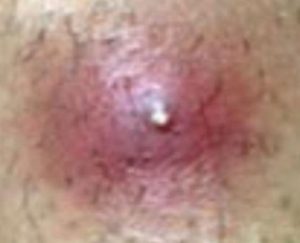
Mild, moderate or severe cause of staph infection can be treated using oral, topical or injectable antibiotic. Seek medical attention for large recurring boils.
Treatment for Infected Ingrown Hair
Treatment for an infected ingrown hair involves managing the symptoms and preventing further infection. Even through some will heal on their own, it is important to seek medical attention to prevent the further infection. Depending on the part of the body the ingrown hair is, the treatment options will include the following:
Your doctor will advise you to stop shaving until the ingrown hair heals completely. This will help reduce further damage and irritation of the hair follicle. It also gives time for the damaged hair follicles to heal. The doctor will also advise against scratching and popping the boils and cysts formed by the ingrown hair.
Another treatment option for an infected boil or cyst formed by an ingrown hair is exfoliating to remove dead skin cells. to make the slough off even more faster, your health care provider can prescribe medical drug that you can apply on the infected surface to push the hair up the surface of the skin.
Topical ointment such as anti-itching and anti-inflammatory creams can also be prescribed to relieve the skin of the itching and inflammation. The creams can also be effective in the reducing the burning sensation and swelling caused by the ingrown hair.
In cases of severe bacterial or viral infection, your health care provider or a dermatology will prescribe oral or injectable antibiotic. For mild cases, ointment antibiotic may be used. These can be inform of creams or gel that will be applied on the infected parts of the skin.
For severe itching caused by the ingrown hair, anti-itching creams and oral painkillers can be prescribed.
Hose with drug allergy or any kind of allergy, those with weak immune system, or those on cancer medication should report to their doctors before taking any of the medication discussed above.
How to Remove Infected Ingrown Hair
Even though most of infected ingrown hair are harmless and will heal on their own, the pain and sever itching caused by them may make you want to get rid of them as soon as possible. Most dermatologist and skin care professional will advise against popping or removing the ingrown air by pluck the entire ingrown hair follicle.
If you are satisfied that removing the ingrown hair is the best way to get rid of it, then you need to make sure you are doing it in a clean and safe environment, with the right, clean and sterilized tools. Instead of plucking the entire infected ingrown hair, the best way will be to remove its tip from underneath the skin using a sterilized needle.
Gently lift the tip of the ingrown hair by slipping below the loop before lifting it up gently. After that, clean the area with antiseptic or antibiotic ointment to help heal and prevent further bacterial infection.
For boils and cyst formed on the ingrown hair, a small incursion can be made on the side. A clean sterilized syringe can then be used to drain out the contents of the bump. Make sure wound left is clean to prevent bacterial buildup that can cause future infections.
Infected Ingrown Hair Follicle
An infected ingrown hair follicles is caused by scratching and popping the bumps formed by an ingrown hair. According to medicine net dot com, abscess or boils can form on an ingrown hair site as a result of infection with common skin bacteria such as staphylococcus.
Staphylococcus bacterial also known as simply staph, is a common skin bacterial that affects an approximately 30 percent of healthy individuals both adults and children. A dermatologist, George G. Kihiczak, says that if the bacteria gets into the body through cuts made by scratching, shaving, waxing and picking the ingrown hair, it can create an abscess that grows until it drains.
The infection caused by, staph can be treated with oral or topical antibiotic. An incursion can also be made on the side of the boil to drain the pus, dead skin cells and other fluids. A common sign of an infected ingrown hair will be a boil filled with foul smell pus.
Home Remedies to Remove Infections on Ingrown Hair
An infected ingrown hair is in most cases very painful and discomforting. That is why you need to prevent it from happening rather than struggling to heal or treat. For some people, mild infection will clear up on their own without any medical assistance, for other the ingrown hair may take long and start to form lesion.
Scratching and squeezing the ingrown hair bumps is what opens the skin for possible bacterial or viral infection. Avoid popping and scratching the bumps to keep the skin intact and facilitate faster healing of the hair follicles. Also to relieve the skin of the itching and inflammation the following home remedy can be used.
Aloe Vera gel is a well-known anti-inflammatory, anti-itching and anti-bacterial agent. Applying the gel on the infected ingrown hair or the boil on the hair follicle will help get rid of the pain, swelling and inflammation. Just pluck a fresh aloe Vera leave and squeeze the gel into a cup, to make an even better remedy, you can mix the gel with raw organic honey. Apply the paste on the ingrown hair. Do these repeatedly twice in a day for a week for optimal result.
The other effective remedy you can use is oatmeal. Oatmeal has been used for long to relieve the skin of itching and inflammation. To make the remedy, grind a considerable amount of oatmeal into a fine powder. Mix the powder with bathing water and mix by stirring until the powder is thoroughly blended into the water. Soak the infected part of the body for 30 minute. Repeat this process for optimal results.
You can also use chamomile tea wash as a remedy for itching and inflammation. Gently rub round the infected area to relive the itching and keep the area clean and free from germs that might cause further infection.
Another natural anti-biotic hiding in the kitchen is raw garlic. Research has shown that raw garlic contains a compound called allicin which has similar properties to penicillin. With these, garlic is considered, anti-inflammatory, anti-viral, anti—parasitic, anti—fungal and antioxidant. It also contains a lot of vitamins, nutrients and minerals that are very beneficial to today’s body wellness.
The other possible remedy you could use to treat an infected ingrown hair is raw apple cider vinegar. This remedy contains antibiotic and antiseptic properties that will help prevent and treat bacterial and viral infection in an ingrown hair. When used, apple cider vinegar will also help relieve the skin of the itching, swelling and inflammation caused by the infection.
Other remedies you can prepare at home include fermented foods, which works to boost and preserve the natural flora in the digestion system. Colloidal silver which is a natural antibiotic and extra virgin coconut oil that has natural occurring anti-fungal and antimicrobial properties.
Seek immediate medical attention if the remedies do not work or the symptoms persist. It is also important to know that the remedy will respond differently from one person to the other.
How to Prevent Infected Ingrown Hair – Tips
To prevent the chance of formation of an ingrown hair, some simple steps and procedures should be taken before applying any hair removal method.
For those who shave, you need to make sure the razor is sharp, clean and sterilized. To do so, you can clean it with alcohol or boil it in water to kill all the germs that might cause an infection.
You also need not to pop or drain and ingrown hair. If that is the only way, then you need to make sure your hands are clean and free from germs. Use a cotton wool or a clean face towel and an antiseptic solution such as salicylic acid or hydrogen peroxide to clean the area around the infected ingrown hair.
You should also make sure the hair is not dry when or after shaving. Use a moistening cream or shaving cream especially for those with curly hair. For those who wax or tweeze to remove hair, make sure the process is done by a professional to avoid damaging the hair follicles and cause an ingrown hair.
You can also consider a laser hair removal method. This is a medical method where hair is removed permanently by damaging the hair follicle using a laser beam. The damaging of the hair follicle inhibits future hair growth.
The other possible way to prevent an ingrown hair is shaving in the direction the hair is growing. This will help reduce the chances of having to damage the hair follicle. In children, you can reduce the skin irritation by applying a cool wash cloth on the skin after shaving.
Finally to prevent an ingrown hair, you can adopt chemical methods of hair removal. Apart from shaving or waxing, you can have your hair removed by using chemicals. Though long last, the chemicals used to prevent hair regrowth can be very irritating to some people.
Maintain high levels of hygiene to reduce the rate of bacterial accumulation and overgrowth. You also need to exercise often to make sure dead skin cells and other harmful microorganism are excreted out of the body through sweating. According to a recent research, something remarkable was revealed about sweating. Beyond the obvious role of regulating the body temperature, sweating was found to eliminate accumulation of heavy metals and petrochemicals.
Sources and references
- How to remove an ingrown hair: http://www.livestrong.com/article/21758-removing-ingrown-hair-face/
- Sweating as a method to detoxify and prevent ingrown hair infection: http://www.greenmedinfo.com/blog/research-confirms-sweating-detoxifies-dangerous-metals-petrochemicals
- Infected ingrown hair symptoms: http://hair.knowfacts.org/ingrown-hair/infected-ingrown-hair-symptoms-pictures-cysts-staph-treatment/
- Infected ingrown hair: http://www.newhealthadvisor.com/Infected-Ingrown-Hair.html
- Infected ingrown hair home remedies: http://www.myhealthwire.com/news/herbs-supplements/796

